QuestionHi! I just introduced a 3 month old cocker spaniel to my apartment of 2 cats and 2 parrots. Things are going pretty well, but I'm having two small issues. For one, the pup (Oreo) keeps eating the cat food and not his dog food. I keep trying to redirect him to his food, but he just turns and runs back to the cat food. I keep having to take the cat food and put it on the counter, which isn't fair to the cats. Should I just let him eat the cat food? It isn't bad for him, is it?
Second, the dreaded crate training. I've tried putting Oreo in his crate at night on the floor next to my bed. He cries and cries... the other night my neighbor banged on my door and asked me to keep the dog quiet. It woke him up. Any tips?
Thanks in advance.
Stephanie
AnswerI don't use the crate next to the bed, but it works for many others. If you can sleep with some light, leave some on. What I do is lay down on the floor next to the crate like I was going to sleep there. Talk or sing to the puppy in a soothing voice. Once my puppy falls asleep, I then go up stairs to bed. I was very desperate the night I stumbled on that one. Fortunately I never was in an apartment when I had a puppy. My neighbors never have complained, but they might have if they realized their dogs were barking because my puppy was crying. I am very happy that doesn't happen any more. Maybe you could put the crate up on a little table so the puppy can see you in bed. Just make sure it can't knock it off. A crying puppy is hard to ignore and sleep through.
Cat food isn't the same as dog food, too rich. Maybe the best thing is to break your cats of having food out all the time. They may be eating too much and be too fat. I think that is as big of a problem for cats as dogs.
Your dog definitely should be narrower at the waist than the hips and chest.
You should be able to easily feel the ribs, but not see them. Each dog is
different. Standard recommendations are a good place to start, but each dog
must have its food adjusted to its individual needs. See
http://www.purina.com/dogs/nutrition.asp?article=292 Poke around on Purina's site and see if they give the same advice for cats. The standard technique for dogs is to take away any uneaten food after 15 minutes. You could feed Oreo in his crate and leave him there the 15 minutes. Take up the cat food, let him out, and take him outside. It would help make the crate seem like a good place.
Much of housebreaking is not training the puppy, but making it easier for your
puppy, you, and your carpet while its body to catches up to its instincts. At
around 8 weeks when the puppy goes to its new home, the time from when it
realizes it has to go, and when it can't wait any longer is a matter of
seconds. Only time will fix that. You can hardly be expected to be attentive
enough to avoid all accidents There is no sense punishing the puppy for your
inattention. It is not fair to punish you either, but you still have to clean
it up if you didn't have the puppy outside in time.
Housebreaking starts before you get home with the new puppy. If you don't have
a crate, buy one. I prefer the more enclosed, den like plastic ones. Skip the
bedding. At first it gets wet, and later it can be chewed into choking
hazards. A wire rack in the bottom will help keep the puppy up out of
accidents at first. They are available with the crates, but a piece of closely
spaced wire closet shelving from a home supply place is cheaper. If you
already have a metal crate, covering it may help. Just make sure you use
something the puppy can't pull in and chew. Dogs that start out in crates as
little puppies, accept them very well. Never leave an unattended puppy loose
in the house. If nobody can watch it, put it in the crate. I suggest letting
the dog have its crate all its life.
Choose a command and spot you want it to use. The less accessible to strays,
the less chance of serious disease. If it is a female, choosing a
non grassy spot will avoid brown spots later. When you bring it home, take it
to the spot and give it the command in a firm, but friendly voice. Keep
repeating the command and let the puppy sniff around. If it does anything,
praise it. Really let it know what a good dog it is and how much you love it,
and maybe a treat. Note, being out there not only means you can praise it,
but it also keeps it from being snatched by a hawk. If it doesn't go, take it
inside and give it a drink and any meals scheduled. A young puppy will need to
go out immediately afterward. Go to the spot and follow the above routine.
Praising it if it goes is extremely important. If it doesn't go, take it back
inside and put it in its crate and try again soon. Do not let it loose in the
house until it does go.
At first it is your responsibility to know and take the puppy out when it
needs to go. It needs to go out the first thing in the morning, after eating,
drinking, and sleeping. If it quits playing, and starts running around
sniffing, it is looking for a place to go. Take it out quickly. You will just
have to be what I call puppy broke until it is a little older.
By the time most dogs are about 3 months old, they have figured out that if
they go to the door and stand, you will let them out. The praise slowly shifts
to going to the door. Some people hang a bell there for the dog to paw. If
your dog doesn't figure this out, try praising it and putting it out if it
even gets near the door. A stern "Bad dog!" is all the punishment that is
effective, and only when you catch it in the act and are sure you didn't miss
it going to the door. Clean up accidents promptly. I mostly keep the little
puppies out of the carpeted rooms. Still I need the can of carpet foam
sometimes. First blot up all the urine you can with a dry towel. Keep moving
it and stepping on it until a fresh area stays dry. A couple big putty knives
work well on bowel movements. Just slide one under it while holding it with
the other. This gets it up with a minimum of pushing it down into the carpet.
This works with even relatively soft ones, vomit, dirt from over turned house
plants, or anything else from solids to thick liquids. Finish up with a good
shot of carpet foam. Note, do not let the puppy lick up the carpet foam.
Once the dog is reliably housebroken, your carpet may need a good steam cleaning.
Many people strongly strongly push cleaning up all evidence of past accidents. I am slower to suggest that. Dogs will return top the same spot if they can find it. When you see one sniffing the spot, that is your clue to run it out.

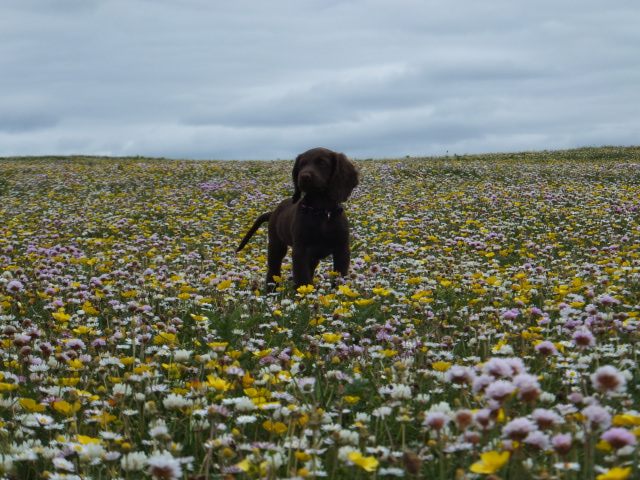 Travelling
QuestionQUESTION: Dear Dolores,
My 7 months old female
Travelling
QuestionQUESTION: Dear Dolores,
My 7 months old female
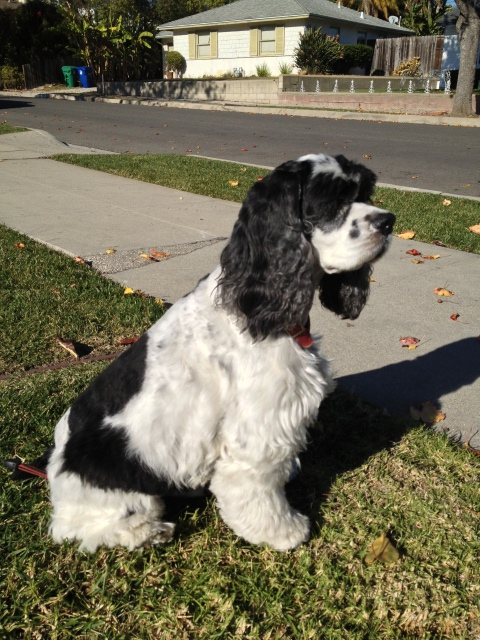 Cocker & Clinging Behavior
QuestionDooley
QUESTION: Dear Dr. Beck,
We have
Cocker & Clinging Behavior
QuestionDooley
QUESTION: Dear Dr. Beck,
We have
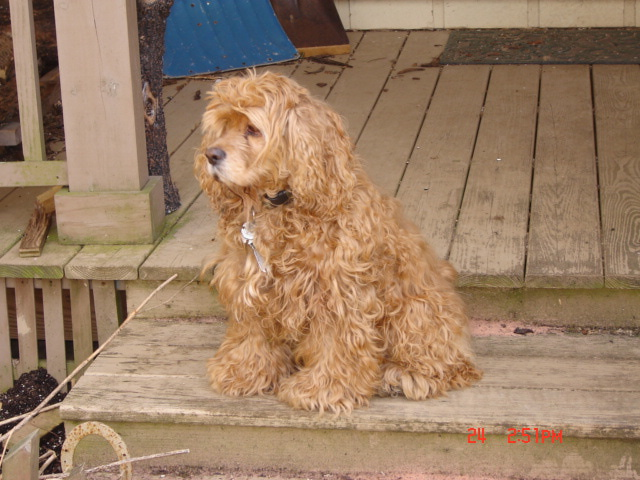 Impacted anal glands in an 11 yr old spayed female
QuestionDaisy
QUESTION: Our cocker spaniel Daisy
Impacted anal glands in an 11 yr old spayed female
QuestionDaisy
QUESTION: Our cocker spaniel Daisy
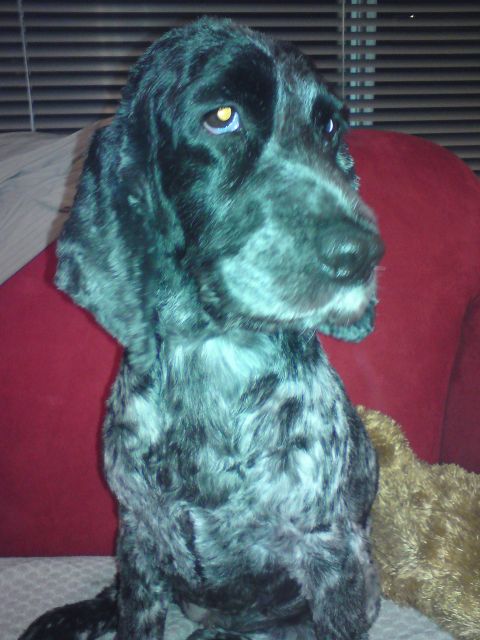 Nervous/depressed cocker spaniel
QuestionSophie
QUESTION: Hi! Sorry if this is a
Nervous/depressed cocker spaniel
QuestionSophie
QUESTION: Hi! Sorry if this is a
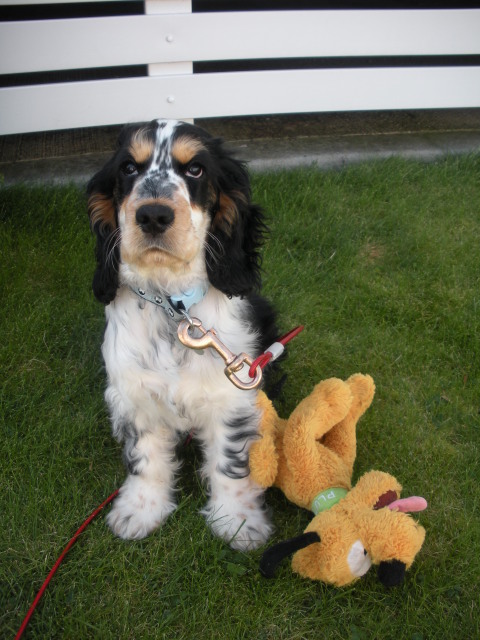 PROBLEM COCKER SPANIEL
Question
JAXON
Jaxon is a year old male neutered
PROBLEM COCKER SPANIEL
Question
JAXON
Jaxon is a year old male neutered